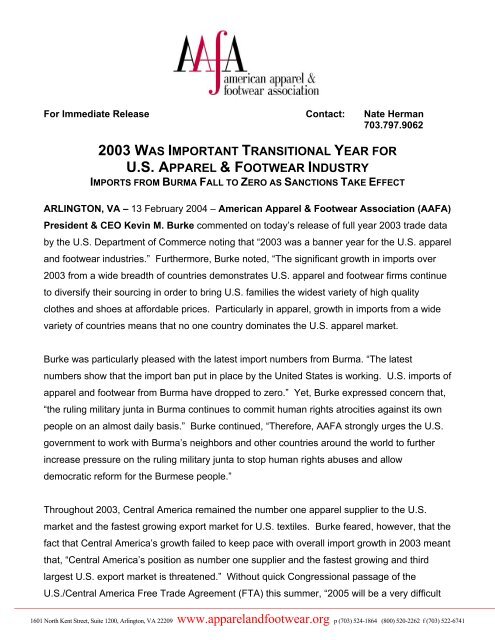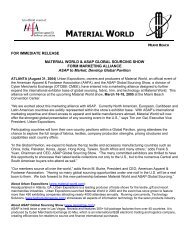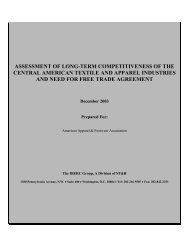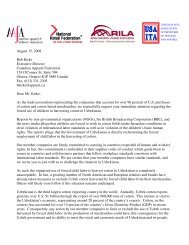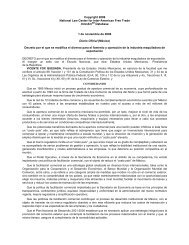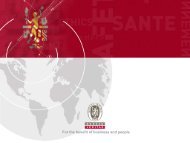2003 was important transitional year for us apparel & footwear industry
2003 was important transitional year for us apparel & footwear industry
2003 was important transitional year for us apparel & footwear industry
You also want an ePaper? Increase the reach of your titles
YUMPU automatically turns print PDFs into web optimized ePapers that Google loves.
For Immediate Release Contact: Nate Herman<br />
703.797.9062<br />
<strong>2003</strong> WAS IMPORTANT TRANSITIONAL YEAR FOR<br />
U.S. APPAREL & FOOTWEAR INDUSTRY<br />
IMPORTS FROM BURMA FALL TO ZERO AS SANCTIONS TAKE EFFECT<br />
ARLINGTON, VA – 13 February 2004 – American Apparel & Footwear Association (AAFA)<br />
President & CEO Kevin M. Burke commented on today’s release of full <strong>year</strong> <strong>2003</strong> trade data<br />
by the U.S. Department of Commerce noting that “<strong>2003</strong> <strong>was</strong> a banner <strong>year</strong> <strong>for</strong> the U.S. <strong>apparel</strong><br />
and <strong>footwear</strong> ind<strong>us</strong>tries.” Furthermore, Burke noted, “The significant growth in imports over<br />
<strong>2003</strong> from a wide breadth of countries demonstrates U.S. <strong>apparel</strong> and <strong>footwear</strong> firms continue<br />
to diversify their sourcing in order to bring U.S. families the widest variety of high quality<br />
clothes and shoes at af<strong>for</strong>dable prices. Particularly in <strong>apparel</strong>, growth in imports from a wide<br />
variety of countries means that no one country dominates the U.S. <strong>apparel</strong> market.<br />
Burke <strong>was</strong> particularly pleased with the latest import numbers from Burma. “The latest<br />
numbers show that the import ban put in place by the United States is working. U.S. imports of<br />
<strong>apparel</strong> and <strong>footwear</strong> from Burma have dropped to zero.” Yet, Burke expressed concern that,<br />
“the ruling military junta in Burma continues to commit human rights atrocities against its own<br />
people on an almost daily basis.” Burke continued, “There<strong>for</strong>e, AAFA strongly urges the U.S.<br />
government to work with Burma’s neighbors and other countries around the world to further<br />
increase pressure on the ruling military junta to stop human rights ab<strong>us</strong>es and allow<br />
democratic re<strong>for</strong>m <strong>for</strong> the Burmese people.”<br />
Throughout <strong>2003</strong>, Central America remained the number one <strong>apparel</strong> supplier to the U.S.<br />
market and the fastest growing export market <strong>for</strong> U.S. textiles. Burke feared, however, that the<br />
fact that Central America’s growth failed to keep pace with overall import growth in <strong>2003</strong> meant<br />
that, “Central America’s position as number one supplier and the fastest growing and third<br />
largest U.S. export market is threatened.” Without quick Congressional passage of the<br />
U.S./Central America Free Trade Agreement (FTA) this summer, “2005 will be a very difficult<br />
1601 North Kent Street, Suite 1200, Arlington, VA 22209 www.<strong>apparel</strong>and<strong>footwear</strong>.org p (703) 524-1864 (800) 520-2262 f (703) 522-6741
<strong>year</strong> <strong>for</strong> Central America and the U.S. textile ind<strong>us</strong>try, leading to potentially widespread and<br />
significant job losses in both ind<strong>us</strong>tries."<br />
U.S. <strong>apparel</strong> imports <strong>for</strong> <strong>2003</strong> grew 9.3 percent over 2002 to 18.9 billion square meter<br />
equivalents (SMEs), according to new figures released today by the U.S. Department of<br />
Commerce. The value of U.S. <strong>apparel</strong> imports increased 7.4 percent in <strong>2003</strong> to $61.2 billion.<br />
U.S. imports from Central America (Costa Rica, El Salvador, Guatemala, Honduras and<br />
Nicaragua) continued to grow, increasing 6.2 percent in <strong>2003</strong> compared with 2002. Central<br />
America is the largest U.S. <strong>apparel</strong> supplier, controlling 15.5 percent of all U.S. imports.<br />
U.S. textile exports <strong>for</strong> <strong>2003</strong> grew 1.8 percent over 2002 to $10.5 billion, according to new<br />
figures released today by the U.S. Department of Commerce. While textile exports to the top<br />
U.S. markets of Mexico (-1.7 percent) and Canada (-2.7 percent) declined <strong>for</strong> the third straight<br />
<strong>year</strong>, U.S. textile exports to Central America (Costa Rica, El Salvador, Guatemala, Honduras<br />
and Nicaragua) continued to grow, increasing 8.4 percent in <strong>2003</strong> compared with 2002.<br />
Central America is the U.S. textile ind<strong>us</strong>try’s fastest growing and third largest export market,<br />
controlling 15.4 percent of all U.S. textile exports.<br />
Continuing long-term declines in imports from Mexico, which fell 8.3 percent in <strong>2003</strong>, helped<br />
knock Mexico out of its long-held slot as the second largest <strong>apparel</strong> supplier to the United<br />
States. Mexico fell to the number three spot, controlling 10.5 percent of all U.S. <strong>apparel</strong><br />
imports. China is now the second largest supplier to the United States, controlling 12.1<br />
percent of total U.S. <strong>apparel</strong> imports in <strong>2003</strong>. U.S. imports from 14 of the top 20 suppliers,<br />
including Central America (1 st ), China (2 nd ), the Dominican Republic (6 th ), Vietnam (7 th ),<br />
Indonesia (8 th ), Taiwan (9 th ), India (12 th ), Cambodia (13 th ), Thailand (14 th ), Pakistan (15 th ),<br />
Macau (17 th ), Turkey (18 th ) and R<strong>us</strong>sia (20 th ), also grew significantly in <strong>2003</strong>. U.S. imports<br />
from Hong Kong (5 th ), South Korea (10 th ) and Canada (19 th ) followed Mexico’s (2 nd ) lead, all<br />
declining significantly in <strong>2003</strong>. U.S. <strong>apparel</strong> imports from Bangladesh (4 th ), the Philippines<br />
(11 th ) and Sri Lanka (16 th ) held steady or declined slightly in <strong>2003</strong>.<br />
U.S. imports from Vietnam grew 134.4 percent during the period, making it the seventh largest<br />
<strong>apparel</strong> supplier to the United States, accounting <strong>for</strong> 3.9 percent of all imports. U.S. imports<br />
from Vietnam, however, dramatically slowed in November and December due to quotas, put in<br />
place by the U.S. government last May, becoming filled in a number of major categories <strong>for</strong> the<br />
2
<strong>year</strong>. This slowdown knocked Vietnam out of the sixth spot that it held <strong>for</strong> most of <strong>2003</strong>.<br />
Thanks to the African Growth and Opportunity Act (AGOA) and the Andean Trade Promotion &<br />
Drug Eradication Act (ATPDEA), U.S. imports from sub-Saharan Africa grew at a rate of 43.9<br />
percent and U.S. imports from the Andean countries of Bolivia, Colombia, Ecuador and Peru<br />
grew at a rate of 34.2 percent in <strong>2003</strong>, with those regions now accounting <strong>for</strong> 2.1 percent and<br />
1.1 percent of total U.S. <strong>apparel</strong> imports, respectively. The top five sources of <strong>apparel</strong> (by<br />
volume) during <strong>2003</strong> were Central America (2.9 billion SME), China (2.3 billion SME), Mexico<br />
(2.0 billion SME), Bangladesh (913 million SME) and Hong Kong (785 million SME).<br />
U.S. total <strong>footwear</strong> imports in <strong>2003</strong> climbed 3.7 percent vers<strong>us</strong> 2002 to 2.0 billion pairs,<br />
according to figures released today by the U.S. Department of Commerce. The value of U.S.<br />
<strong>footwear</strong> imports increased 1.2 percent in <strong>2003</strong> to $15.6 billion. China grew 5.2 percent in<br />
<strong>2003</strong>, giving it control of 81.2 percent of all U.S. <strong>footwear</strong> imports, while imports from Vietnam<br />
grew 61.6 percent in <strong>2003</strong>, making it the fifth largest <strong>footwear</strong> supplier to the U.S. market.<br />
Brazil, the United States' number two supplier, also grew in <strong>2003</strong>, with U.S. imports from Brazil<br />
increasing 1.6 percent to 103.3 million pairs or 5.1 percent of all U.S. <strong>footwear</strong> imports.<br />
Reversing many <strong>year</strong>s of decline, U.S. <strong>footwear</strong> imports from top twenty suppliers Mexico (6 th )<br />
and Taiwan (8 th ) experienced significant increases in <strong>2003</strong> vers<strong>us</strong> 2002. India (12 th ), Canada<br />
(13 th ), Romania (17 th ), France (18 th ) and Poland (19 th ) are four other top 20 suppliers growing<br />
at a quick pace. The top ten suppliers in <strong>2003</strong> supplied over 97 percent of all U.S. <strong>footwear</strong><br />
imports. The top ten U.S. import sources of <strong>footwear</strong> (by quantity) in <strong>2003</strong> were China (1.6<br />
billion pairs), Brazil (103.3 million pairs), Indonesia (56.9 million pairs), Italy (40.3 million pairs),<br />
Vietnam (34.0 million pairs), Mexico (30.9 million pairs), Thailand (25.3 million pairs), Taiwan<br />
(14.1 million pairs), the Dominican Republic (10.7 million pairs) and Hong Kong (10.1 million<br />
pairs).<br />
###<br />
The American Apparel & Footwear Association (AAFA) is the national trade association representing<br />
<strong>apparel</strong>, <strong>footwear</strong> and other sewn products companies, and their suppliers, which compete in the global<br />
market. AAFA's mission is to promote and enhance its members' competitiveness, productivity and<br />
profitability in the global market by minimizing regulatory, commercial, political, and trade restraints.<br />
3


